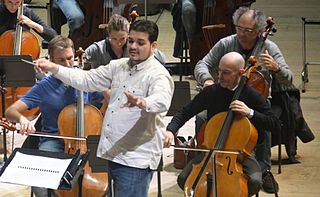Band or BAND may refer to:

A musical ensemble, also known as a music group, musical group, or a band is a group of people who perform instrumental and/or vocal music, with the ensemble typically known by a distinct name. Some music ensembles consist solely of instrumentalists, such as the jazz quartet or the orchestra. Other music ensembles consist solely of singers, such as choirs and doo-wop groups. In both popular music and classical music, there are ensembles in which both instrumentalists and singers perform, such as the rock band or the Baroque chamber group for basso continuo and one or more singers. In classical music, trios or quartets either blend the sounds of musical instrument families or group instruments from the same instrument family, such as string ensembles or wind ensembles. Some ensembles blend the sounds of a variety of instrument families, such as the orchestra, which uses a string section, brass instruments, woodwinds, and percussion instruments, or the concert band, which uses brass, woodwinds, and percussion. In jazz ensembles or combos, the instruments typically include wind instruments, one or two chordal "comping" instruments, a bass instrument, and a drummer or percussionist. Jazz ensembles may be solely instrumental, or they may consist of a group of instruments accompanying one or more singers. In rock and pop ensembles, usually called rock bands or pop bands, there are usually guitars and keyboards, one or more singers, and a rhythm section made up of a bass guitar and drum kit.

A military band is a group of personnel that performs musical duties for military functions, usually for the armed forces. A typical military band consists mostly of wind and percussion instruments. The conductor of a band commonly bears the title of bandmaster or music director. Ottoman military bands are thought to be the oldest variety of military marching bands in the world, dating from the 13th century.
A fanfare is a short musical flourish which is typically played by trumpets, French horns or other brass instruments, often accompanied by percussion. It is a "brief improvised introduction to an instrumental performance". A fanfare has also been defined in The Golden Encyclopedia of Music as "a musical announcement played on brass instruments before the arrival of an important person", such as heralding the entrance of a monarch. Historically, fanfares were usually played by trumpet players, as the trumpet was associated with royalty. Bugles are also mentioned. The melody notes of fanfare are often based around the major triad, often using "heroic dotted rhythms".

A brass band is a musical ensemble generally consisting primarily of brass instruments, most often with a percussion section. Ensembles that include brass and woodwind instruments can in certain traditions also be termed brass bands, but may be more correctly termed military bands, concert bands, or "brass and reed" bands.

A corps of drums, sometimes known as a fife and drum corps or simply field music, is a traditional European military music formation. Historically, a Corps of Drums' primary role was communication. Today, the primary role of a Corps of Drums is ceremonial, performing in parades and military ceremonies. Besides drums, this formation may contain a variety of instruments, including trumpets, bugles, and fifes.

A fanfare band, fanfare corps, fanfare battery, fanfare team, horn and drum corps, bugle band, drum and bugle corps, or trumpet and drum band is a military or civilian musical ensemble composed of percussion instruments, bugles, natural horns and natural trumpets. Fanfare bands are the descendants of the old medieval trumpet and drum teams that sounded fanfares on important occasions and are related to drum and bugle corps internationally.

A fanfare orchestra is a type of brass band consisting of the entire saxophone family, trumpets, trombones, euphoniums, baritone horns, flugelhorns and alto/tenor- or F-horns, as well as percussion. They are seldom seen outside of Europe, with a high concentration of these bands in Belgium and the Netherlands, many of them civil bands with a few Dutch bands also serving the Armed forces of the Netherlands and its veterans.

Canadian military bands are a group of personnel in the Canadian Armed Forces (CAF) that performs musical duties for military functions. Military bands form a part of the Music Branch of the CAF, composed of six full-time professional Regular Force bands, 15 Regular Force voluntary bands, and 53 part-time reserve force bands. Bands of the Music Branch are often badged with the unit or Canadian Forces base insignia that they support.
Hendrickus Cornelius "Henk" van Lijnschooten was a Dutch composer, who also wrote under the names Ted Huggens and Michel van Delft.

Giancarlo Castro D'Addona is a Venezuelan – Italian composer, conductor and trumpet player. Gold medal winner at the Global Music Awards in San Diego – California (US).

A fanfare trumpet, also called a herald trumpet, is a brass instrument similar to but longer than a regular trumpet, capable of playing specially composed fanfares. Its extra length can also accommodate a small ceremonial banner that can be mounted on it.

The Music of the Foreign Legion, formerly known as the Principal Music of the Foreign Legion is a Military band of the French Foreign Legion.

A police band is a military-style band operated or sponsored by a police force. Police bands provide ceremonial support for civic events, and perform at police observances such as funerals and police academy graduations. Most police bands consists exclusively of professional police officers, while others consist of personnel of law enforcement and other special agencies. Like military bands, their repertoire is mostly composed of ceremonial marching music and honors music.

Russian military bands fall under the jurisdiction of the Military Band Service of the Armed Forces of Russia, which is the official music service for the Russian Armed Forces, and led by the Senior Director of Music, a billet of an officer with the rank of a Colonel or a general officer. There are between 200 and 300 military bands in the Russian Armed Forces that span across the military as well as all uniformed services in the country. All bands, active or reserve, are composed of graduates from the military music training centers stationed anywhere in the country, as well as of civilian conservatories. While choirs may be attached to military bands, individual staff choirs do not exist in the Russian Armed Forces, since they have attached instrumental ensembles or orchestras. As of 2009, all military musicians are paid around 13,000 rubles ($169.65) for their service in the Armed Forces and other uniformed organizations.

A mounted band is a military or civilian musical ensemble composed of musician playing their instruments while being mounted on an animal. The instrumentation of these bands are limited, with the musician having to play their instrument, as well as steer the animal to the designated location. Most mounted bands, therefore, use instruments that can easily be held, such as bugles, horns, and Fanfare trumpets. Timpani and glockenspiels are also a common feature, usually located at the head of a band. Although a band that is mounted on any member of the families Equidae and Camelidae are considered to be a mounted band, horses are most commonly used, mostly being employed in military bands in Europe, North and South America, and some parts of Asia.

The Royal Military Band "Johan Willem Friso", also informally called the Band of the Royal Netherlands Army or the Johan Willem Friso Military Band is a Dutch military unit in the Koninklijke Landmacht which is the seniormost of all the military bands in the Netherlands Armed Forces, as well as the oldest of the four professional bands currently in existence in the army. It provides musical support for ceremonial events of national importance involving the army, the government, and the Dutch royal house. The repertoire of the band ranges from a variety of different genres, including military marches and contemporary/classical arrangements of symphonic music.

The Fanfare Band of the Royal Marechaussee is a 60-member fanfare band which serves as the official ensemble of the Dutch Royal Marechaussee. It is currently led by Captain Peter Kleine Schaars. It is currently based in Apeldoorn. Being a professional military band representing a service branch of the Dutch Armed Forces, it consists of many different ensembles, including a saxophone quartet, and a percussion section. Also, it maintains a drum and bugle corps component.

The military bands of the United Kingdom are musical units that serve for protocol and ceremonial duties as part of the British Armed Forces. They have been the basis and inspiration for many military bands in the former British Empire and the larger Commonwealth of Nations as well as musical organizations in other countries. Military musical units with British influence include United States military bands, the Japan Ground Self-Defense Force Music Corps and the Military Band of Athens. British military bands are controlled by the military music departments of the three services that compose the armed forces. These include the Royal Marines Band Service, the Royal Corps of Army Music, and the Royal Air Force Music Services. British style brass bands and carnival bands were then and are currently inspired by the British Armed Forces and its brass bands, especially of the Army's regular and reserve formations, as they follow a similar format as it relates to brass and percussion instruments.

Tanjidor is a traditional Betawi musical ensemble developed in Jakarta, Indonesia. This musical ensemble took the form of a modest orchestra and was developed in the 19th century, pioneered by Augustijn Michiels better known as Major Jantje in the Citrap or Citeureup area on the outskirt of Batavia.